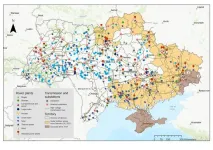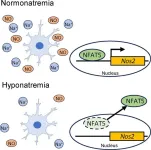(Press-News.org) Risk calculators are used to evaluate disease risk for millions of patients, making their accuracy crucial. But when national models are adapted for local populations, they often deteriorate, losing accuracy and interpretability. Investigators from Brigham and Women’s Hospital, a founding member of the Mass General Brigham healthcare system, used advanced machine learning to increase the accuracy of a national cardiovascular risk calculator while preserving its interpretability and original risk associations. Their results showed higher accuracy overall in an electronic health records cohort from Mass General Brigham and reclassified roughly one in ten patients into a different risk category to facilitate more precise treatment decisions. The results are published in JAMA Cardiology.
“Risk calculators are incredibly important as they are an integral part of the conversation between providers and patients on risk prevention,” said first author Aniket Zinzuwadia, MD, a resident physician in Internal Medicine at Brigham and Women’s Hospital. “But sometimes, when applying these global calculators to local populations, there is variability inherent to the nature of an area—whether that is different demographic characteristics, different physician practice patterns, or different risk factors—so we wanted to find a way to tailor the foundational cardiovascular disease risk model to local populations in a safe way that builds upon what is already being done.”
The American Heart Association released the Predicting Risk of Cardiovascular Disease Events (PREVENT) calculator in 2023 for adults ages 30-79. This new and improved tool helps predict the likelihood of a person developing a heart attack, stroke, or heart failure in 10 years and in 30 years. While the PREVENT equations have done well at assessing risk at a national level, the researchers wanted to test if their technique could better calibrate the risk assessment for more local populations.
In the study, researchers used electronic health record data from 95,326 Mass General Brigham patients who were 55 or older in 2007 and who had at least one lipid or blood pressure measurement between 1997-2006 and at least one encounter with the hospital system between 2007-2016. The team used XGBoost, an open-source machine learning library, to recalibrate PREVENT’s equations while still preserving the associations of known risk factors with the outcomes observed in the original model. The results demonstrated greater accuracy and the reclassification of one out of ten patients in this population.
“This could theoretically represent a group of patients that might not have been prescribed statin therapies in the original application of the model, for example, but who might have benefited from them,” said Zinzuwadia.
While more steps are needed before this technique could be applied to patient care, the team would like to see how it performs in the local populations of other healthcare systems and, eventually, for clinicians and researchers to use the tool to tailor global risk models.
“A major challenge of applying AI to medical research is ensuring that machine learning models are not just flexible, but also transparent, reliable, and grounded in domain knowledge,” said co-senior author Olga Demler, PhD, an associate biostatistician at Brigham and Women’s Hospital’s Division of Preventive Medicine. “Our approach shows that it is possible to avoid the ‘black box’ nature of AI applications and may offer a path forward where sophisticated algorithms can retain their flexibility while producing guarantees of their performance.”
Authorship: Additional authors include Olga Mineeva, Chunying Li, Zareen Farukhi, Franco Giulianini, Brian Cade, Lin Chen, Elizabeth Karlson, Nina Paynter, and Samia Mora.
Disclosures: Samia Mora has served as a consultant to Pfizer for work outside the current study. Olga Demler and Nina Paynter have received funding from Kowa Research Institute for work unrelated to the current study. Aniket Zinzuwadia has served as an employee of Heartbeat Health for work outside the current study.
Funding: Researchers were supported by the National Heart, Lung, and Blood Institute (K24 HL136852, R21 HL156174, R21HL167173, K01HL135342, and R21125962), the American Heart Association (17IGMV33860009),
the Swiss Federal Institute of Technology (ETH, Zurich, Switzerland), Dataspectrum4CVD from the Swiss Data Science Center/Personalized Health & Related Technologies, Zurich, Switzerland, and the National Human Genome Research Institute (U01HG008685).
Paper cited: Zinzuwadia A, et al. “Tailoring risk prediction models to local populations: Machine learning recalibration preserving interpretability of PREVENT.” JAMA Cardiology, DOI: 10.1001/jamacardio.2024.2912
END
Brigham researchers use machine learning to improve cardiovascular risk assessment
A transparent AI approach recalibrated the new PREVENT equations to provide a more tailored cardiovascular risk assessment in a local population
2024-09-18
ELSE PRESS RELEASES FROM THIS DATE:
How Ukraine can rebuild its energy system
2024-09-18
One of the main targets of Russia’s ongoing attacks on Ukraine is the energy infrastructure. The extent of the destruction is enormous. “One year after the start of the war in February 2022, 76 percent of thermal power plants had been destroyed; now the figure is 95 percent,” says Ukrainian scientist Iryna Doronina. “And all the large hydroelectric power plants have also failed.” The breaching of the Kakhovka dam proved to be particularly devastating. The huge outflow of water – the reservoir ...
Research points a way to modulate scarring in spinal cord injury
2024-09-18
Media Contact: laura.kurtzman@ucsf.edu, (415) 502-6397
Subscribe to UCSF News
After a spinal cord injury, nearby cells quickly rush to action, forming protective scar tissue around the damaged area to stabilize and protect it. But over time, too much scarring can prevent nerves from regenerating, impeding the healing process and leading to permanent nerve damage, loss of sensation or paralysis.
Now, UC San Francisco researchers have discovered how a rarely studied cell type controls the formation of scar tissue in spinal cord injuries. Activating ...
Breast and ovarian cancer newly linked to thousands of gene variants
2024-09-18
Scientists have pinpointed thousands of genetic changes in a gene that may increase a person’s risk of developing breast and ovarian cancer, paving the way for better risk assessment and more personalised care.
Researchers from the Wellcome Sanger Institute and their collaborators focused on the ‘cancer protection’ gene RAD51C, finding over 3,000 harmful genetic changes that could potentially disrupt its function and increase ovarian cancer risk six-fold and risk of aggressive subtypes of breast ...
Metal exposure can increase cardiovascular disease risk
2024-09-18
Metal exposure from environmental pollution is associated with increased calcium buildup in the coronary arteries at a level comparable to traditional risk factors like smoking and diabetes, according to a study published today in JACC, the flagship journal of the American College of Cardiology. The findings support that metals in the body are associated with the progression of plaque buildup in the arteries and potentially provide a new strategy for managing and preventing atherosclerosis.
"Our findings highlight the importance ...
Penny for your thoughts? Master copper regulator discovery may offer Alzheimer’s clues
2024-09-18
New therapeutic opportunities often emerge from research on simple organisms. For instance, the 2020 Nobel Prize in Chemistry awarded to Emmanuelle Charpentier, Ph.D., and Jennifer Doudna, Ph.D., for their CRISPR-based DNA editing discovery began with studies using bacteria just a decade prior. Today, CRISPR therapies are approved for several disorders, and more such treatments are in the offing.
Recognizing the translational potential of studies in simpler animal models, a team of scientists led by Randy D. Blakely, ...
Keck Hospital of USC named a 2024 top performer by Vizient, Inc.
2024-09-18
LOS ANGELES — Keck Hospital of USC has been named a top performer in the 2024 Bernard A. Birnbaum, MD, Quality Leadership award by Vizient, Inc., a leading health care performance improvement company.
The top performer designation acknowledges the hospital’s excellence in delivering high-quality care as measured by the annual Vizient Quality and Accountability Study.
Keck Hospital was among 14 top performers out of 115 comprehensive academic medical centers nationally and achieved a five-star ...
NSF and Simons Foundation launch 2 AI Institutes to help astronomers understand the cosmos
2024-09-18
Note: Embargoed until 8:00 a.m. ET on Sept. 18, 2024
From the early telescopes made hundreds of years ago by Galileo to the sophisticated astronomical observatories of today, people have built increasingly innovative tools to probe and measure the cosmos. Soon, researchers at two new institutes funded by the U.S. National Science Foundation and the Simons Foundation will build a new breed of astronomical tools by harnessing the uniquely powerful abilities of artificial intelligence to assist and accelerate humanity's understanding of the universe.
The new National Artificial Intelligence ...
Exploring the effect of low sodium concentrations on brain microglial cells
2024-09-18
Low serum sodium concentrations in blood are called hyponatremia, a prevalent clinical electrolyte disorder. In contrast to acute hyponatremia, chronic hyponatremia has been previously considered asymptomatic because the brain can successfully adapt to hyponatremia. If not treated, chronic hyponatremia can lead to complications such as fractures, falls, memory impairment, and other mental issues. Treating the chronic condition is, however, quite tricky as it has been observed that overly rapid correction of hyponatremia ...
New Alzheimer’s studies reveal disease biology, risk for progression, and the potential for a novel blood test
2024-09-18
EMBARGOED by Alzheimer’s & Dementia until 7 a.m., ET, Sept. 18, 2024
Contact: Gina DiGravio, Boston University, 617-358-7838, ginad@bu.edu
Contact: Andrea Zeek, IU School of Medicine, 317-671-3114, anzeek@iu.edu
(Boston)— The failure to diagnose Alzheimer’s disease, the most common form of dementia in the elderly, at an early stage of molecular pathology is considered a major reason why treatments fail in clinical trials. Previous research to molecularly diagnose Alzheimer’s disease yielded "A/T/N" central biomarkers based on the measurements of proteins, β-amyloid (“A”) and tau (“T”), ...
Comorbidity and disease activity in multiple sclerosis
2024-09-18
About The Study: In this study, a higher burden of comorbidity was associated with worse clinical outcomes in people with multiple sclerosis (MS), although comorbidity could potentially be a partial mediator of other negative prognostic factors. The findings suggest a substantial adverse association of the comorbidities investigated with MS disease activity and that prevention and management of comorbidities should be a pressing concern in clinical practice.
Corresponding Author: To contact the corresponding author, Amber Salter, PhD, email amber.salter@utsouthwestern.edu.
To access the embargoed study: Visit our For The Media website at this ...
LAST 30 PRESS RELEASES:
Pure bred: New stem cell medium only has canine components
Largest study of its kind highlights benefits – and risks – of plant-based diets in children
Synergistic effects of single-crystal HfB2 nanorods: Simultaneous enhancement of mechanical properties and ablation resistance
Mysterious X-ray variability of the strongly magnetized neutron star NGC 7793 P13
The key to increasing patients’ advance care medical planning may be automatic patient outreach
Palaeontology: Ancient tooth suggests ocean predator could hunt in rivers
Polar bears may be adapting to survive warmer climates, says study
Canadian wildfire smoke worsened pediatric asthma in US Northeast: UVM study
New UBCO research challenges traditional teen suicide prevention models
Diversity language in US medical research agency grants declined 25% since 2024
Concern over growing use of AI chatbots to stave off loneliness
Biomedical authors often call a reference “recent” — even when it is decades old, analysis shows
The Lancet: New single dose oral treatment for gonorrhoea effectively combats drug-resistant infections, trial finds
Proton therapy shows survival benefit in Phase III trial for patients with head and neck cancers
Blood test reveals prognosis after cardiac arrest
UBCO study finds microdosing can temporarily improve mood, creativity
An ECOG-ACRIN imaging study solves a long-standing gap in metastatic breast cancer research and care: accurately measuring treatment response in patients with bone metastases
Cleveland Clinic presents final results of phase 1 clinical trial of preventive breast cancer vaccine study
Nationally renowned anesthesiology physician-scientist and clinical operations leader David Mintz, MD, PhD, named Chair of the Department of Anesthesiology at the UM School of Medicine
Clean water access improves child health in Mozambique, study shows
Study implicates enzyme in neurodegenerative conditions
Tufts professor named Fellow of the National Academy of Inventors
Tiny new device could enable giant future quantum computers
Tracing a path through photosynthesis to food security
First patient in Arizona treated with new immune-cell therapy at HonorHealth Research Institute
Studies investigate how AI can aid clinicians in analyzing medical images
Researchers pitch strategies to identify potential fraudulent participants in online qualitative research
Sweeping study shows similar genetic factors underlie multiple psychiatric disorders
How extreme weather events affect agricultural trade between US states
Smallholder farms maintain strong pollinator diversity – even when far from forests
[Press-News.org] Brigham researchers use machine learning to improve cardiovascular risk assessmentA transparent AI approach recalibrated the new PREVENT equations to provide a more tailored cardiovascular risk assessment in a local population




